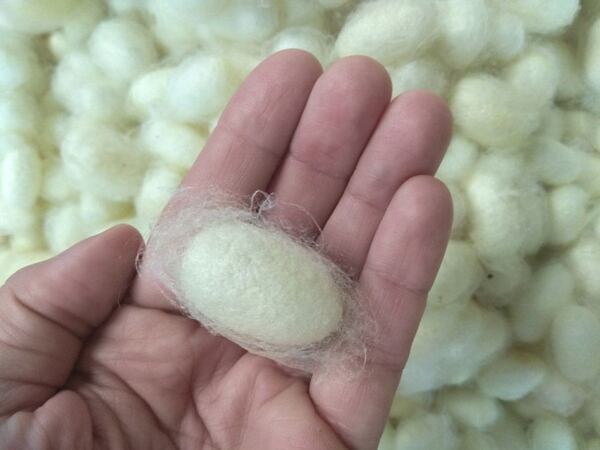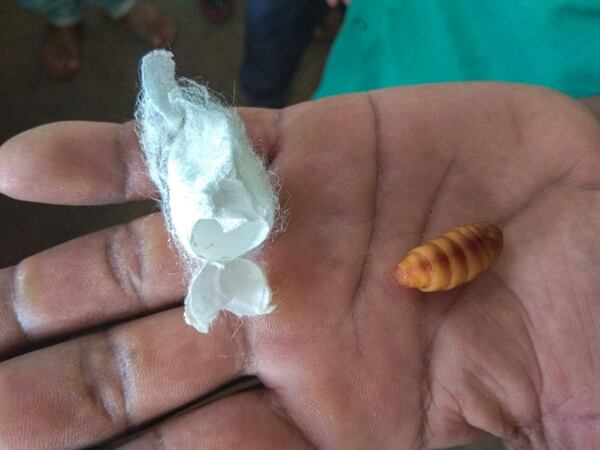
Opening out before me was a wide hall just bursting with fluffy white and yellow clouds. The space was packed end-to-end with tables supporting bins of cocoons of all sizes and every shade from snow white to buttercup yellow. It was like drowning in a sea of silk. As we waded through the narrow aisles among the mountains of cocoons, I plunged my hands into the white gold and started asking questions.
How does the silk cocoon market work?
Silk cocoon markets, like the one that I visited, are operated directly by the Indian government and are the only places where cocoons can be legally traded in India. Official government involvement guarantees that quality standards are met and provides conditions where the price of the cocoons can be set on the basis of free-market principals of supply and demand. Participants pay a (not prohibitive) fee to take part in the market.
Mulberry silkworm farmers and silk reelers meet at the market seven days a week, 365 days a year. Farmers arrive with their goods early in the morning. Each batch undergoes a thorough inspection. The age of the cocoons is verified – each cocoon must have a live pupa inside in order to be accepted. The type of silkworm is also recorded, as is the quality of the cocoons, estimated silk yield, and estimated market value. Each batch of cocoons is marked with this data, plus the name of the cultivator and the place of origin, which plays a major role in determining the price. The tagged goods are sent to their designated places in the great hall, where buyers can make a hands-on inspection.

There are two types of silk cocoons traded at the market – the well-known snow-white cocoons of the mulberry silkworm of the species bombyx mori, generally considered to produce the best, most expensive silk, and the yellowish cocoons of a different silkworm crossbreed.
In the Indian subcontinent, the breeding process of mulberry silk moths takes place twice a year – meaning that silk cocoons are spun twice annually, each containing about 1,000 m of silk filament. There are also specially bred silk moths that breed six to eight times per year, each cocoon containing 800 m of silk filament. Their cocoons contain a different protein group, which lends them a yellow tint, and they usually fetch lower prices. In terms of quality, however, they are similar to mulberry silk, and once the filament has been reeled it is very difficult to tell the difference.

Making a deal
Buyers walk the halls, occasionally dipping their hands into the mounds of cocoons, stopping for a word here and there with one of the farmers. But when the huge, digital display overhead comes to life, all activity stops and a charge of expectation fills the air.

These simple farmers in their threadbare work clothes, some with no shoes on their feet, whip smartphones from their pockets and begin feverishly interacting through a special application. The whole auction is digital.
Buyers, having gleaned the information they need from their rounds of the floor, begin sending anonymous bids on the batches that caught their eye. Highest offers flash on screens set at intervals on the wall. The numbered codes representing buyers and cocoon batches display alongside each bid. Watching the scene unfold, I was reminded of a typical day at a busy airport, where travelers turn their eyes to the arrivals and departures boards.
The auction closes twice daily, at 10:30 and again at 11:30. If the highest offer is accepted, then the cocoons exchange hands. But that doesn’t always happen – if a farmer thinks the highest offer is still too low, they can refuse it. Everyone concentrates on their mobile phone, endlessly speculating whether to bid, close a deal, or wait for a higher bid. Keeping a cool head in those conditions takes talent and experience. Myself, I got so worried for the sellers as the 11:30 deadline loomed that I had butterflies in my stomach. Of course, they were all far more at ease. ????
Live cocoons only!
The cocoon markets are the only place in India where this raw material for making silk can be legally bought or sold. But there’s something else that’s special about them too… the pupae inside of the cocoons are still alive! That sets them apart from the cocoon markets in China, where cocoons are run through a hot-air stove immediately after harvest, killing the chrysalis and conserving the cocoon so farmers can store them for up to a year.
The fact that the cocoons are sold while the pupae are still alive means that they are very fresh, guaranteeing the buyer quality material. A pupa lives in its cocoon only eight to ten days. The first half of that time they have to be left in optimum conditions on the farm until they have finished spinning their silk. It’s not until then that the cocoons can be dismounted and taken to market. The short lifecycle of the pupa only allows a window of five days for cocoons to be brought to market, sold, transported, and processed into silk thread or at least conserved. If the process were to take longer, the pupa would break out of its cocoon, damaging the “endless” silk filament. The time factor plays a big role in negotiations. As the days pass, the farmers lower their prices in order to sell in time.

What’s next for the cocoons?
It’s just past noon. The adrenalin rush has dissipated and the halls are filled with the purposeful shuffle of workers. All deals have been made. Now what remains is getting goods to their new owners to be taken away. The cocoons await their fate – to be made into exquisite silk thread, fine and lustrous… About that, read more in my article about how silk is made – from cocoon to silk thread.
Interesting facts
A single silk cocoon produces up to a kilometer of silk filament
It takes seven kilograms of cocoons to make one kilogram of silk thread
One kilogram of silk thread makes almost eight meters of 114 cm wide silk fabric such as satin or crêpe de chine
So, a kilogram of silk cocoons yields about a meter of silk satin
Indian silk fabrics in stock
Our Indian silks are produced exclusively for Sartor Bohemia without any third party. We directly support small family weavers that we hand select ourselves.







Comments(0)